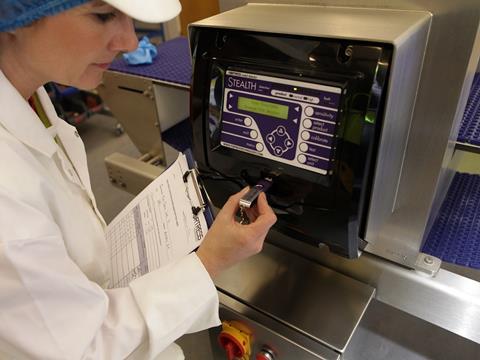
Phil Brown, Managing Director at Fortress Technology Europe discusses metal, the biggest and most likely contaminant risk within food processing and packing plants today.
Additionally, allergen and pathogen related food safety incidents on the rise. Fortress Technology has recently unveiled its latest ultra-hygienic gravity unit for snacks and dry food and pipeline liquid line metal detectors. Both systems feature fewer flat surfaces to overcome product spillage building up, and easy access reject systems for quicker, more thorough high-pressurised washdowns.
Why is metal the most common contaminant?
In the raw ingredient phase, food is exposed to different processes - from cutting meat, filleting fish, grinding spice or mixing dry and wet baking ingredients. Later down the line, cutting larger quantities into more convenient single serve portions or preparing ready-cut vegetables can again introduce a possible metal contaminant into the food supply chain.
How has the rapid uptake of automation impacted food safety on food processing lines?
Introducing automated processes has helped to improve efficiencies, and product costs in some situations. However, having fewer manual workers on a line means there are fewer eyes to visually inspect wear of machine parts and this can increase the risk of metal contaminants.
Installing a metal detection system is the first line of defence. However, it is equally important to use metal detection in conjunction with a quality assurance programme to control rejects and determine the source of any contaminants. Equipped with this information, appropriate actions can be taken to protect against costly product recalls and damage to brand reputation.

How have retailer requirements impacted food safety standards?
In recent years, retailers have become more risk-averse when it comes to food safety and quality, imposing their own – increasingly stringent – protocols and standards on suppliers. Food processors can feel overwhelmed by the sheer extent of choices, food safety initiatives and third-party audits that they must contend with. Companies need to ensure that the required form of inspection and necessary specifications are in place. A retailer ‘safety net’ will also often include assurances about regular system checks to ensure that all QA systems – including metal detection – are functioning correctly.
Some retailers may put pressure on suppliers to invest in x-ray contaminant detection. Being able to demonstrate the reliability and improved sensitivity of metal detectors can help offset this pressure.
Why choose metal detectors over x-ray?
Cost is usually a major reason why processors choose metal detectors over x-ray. X-ray remains far more expensive, both in terms of capital cost and running costs. Expect to pay in the region of £35,000 to £80,000 to install an x-ray machine, compared to £4,000 to £18,000 for metal detection, depending on the size and complexity of the application. Additionally, the price differential between metal detectors and x-ray systems increases incrementally according to the size of the aperture.
Before selecting the type of inspection equipment, buyers should first determine the potential sources of contamination on the particular product line and manufacturing process. If the most common contaminant is metal, or mostly metal, it makes sense to consider metal detection as a first option.
If a processor needs to detect physical contaminants on free-falling products, they should use metal detectors rather than X-ray due to the inconsistent density within the falling product stream. For manufacturers constrained by limited line space, the larger size of x-ray units may also be a decisive factor.
Does in-foil packaging rule out metal detectors?
Not necessarily. In the past, the issue of detecting metal in foil-laminate packaging was more challenging. Now, metal detectors can phase out and run products packaged in laminate foils with a good level of sensitivity. However, pure aluminium foil (i.e. an oven ready tray) may be too challenging, and that’s when an In Foil Detector would then be recommended.
Another potential disadvantage with x-ray is even the latest systems tend not to tolerate difficult or extreme environments quite as well as metal detection. Also, an x-ray machine may have trouble detecting smaller particles and low-density metals – such as aluminium – that metal detectors will easily pick up.
Are false rejects a big problem?
Factory food waste is a large and continually growing issue for manufacturers and one where choices about production equipment (including metal detection and other quality control protocols) can impact waste. For example, reliable industry experts put the annual cost of false rejects per line at around £14,000, depending on the scale of the problem.
False rejections occur when perfectly good product is identified as containing a contaminant. It’s more common on lines handling ‘wet’ items, including anything from dairy products to baked bread, dips to meat, and foods containing high levels of salt or other mineral fortification. The common element is a strong ‘product effect’, which registers relatively high conductivity and magnetic permeability, mimicking the signal picked up from metal and making the distinction between the two hard to establish. Fortress Technology’s Interceptor metal detector addresses this by applying both high and low frequency ranges to isolate the product signal and identify any contaminant signature.

How can I act more sustainably and future proof my equipment investment?
Although today’s inspection and detection systems are good, it’s equally important to ensure they are suited to your operational environment. Unsurprisingly, food processors can feel overwhelmed by the sheer extent of choices and food safety initiatives they have to contend with, let alone anticipating future food safety requirements.
The Fortress ‘Never Obsolete Commitment’ helps customers stay ahead of the curve. This backward-compatibility programme enables customers to upgrade any existing Fortress detector (even those built 21 years ago) helping food processors stay compliant. For example, when a retailer issues a Codes of Practice update an upgrade might only set a manufacturer back several hundred rather than thousands of pounds. Also, the cost can be offset through the maintenance budget instead of eating into capital expenditure.










